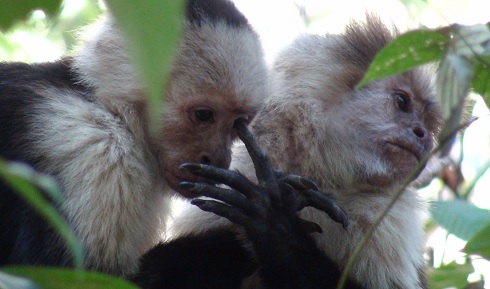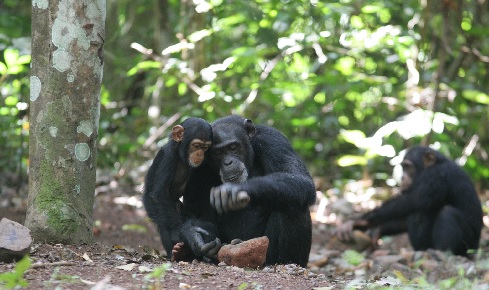Cultural revolution

Professor Andrew Whiten FRSB explores the emerging evidence of ‘animal culture’ and its importance in evolution
February 21st 2022
In the lush forests of Costa Rica, white-faced capuchins typically engage in busy, often frantic-looking foraging and other activities. However, Susan Perry, an evolutionary anthropologist at UCLA who studies these small, yet large-brained, primates[1], was puzzled and intrigued to see pairs of monkeys sitting together and entering into what looked like a kind of trance, while sticking their fingers up the nostrils or in the mouth of their partner. Conversely, they might take another’s fingers and insert them in their own orifices.
The function of such behaviour was not the only mystery, for as her research expanded to encompass multiple social groups, these weird antics were found to be customary in just five out of 13 groups. One variation found in just one group involved poking the finger between eyeball and orbit – making observers wince.
Further painstaking research suggested that these variations are local social customs, perhaps to signal strong bonds between partners[1]. Their patchy distribution across groups cannot be explained by environmental factors, nor genetics, because their diffusion within groups and eventual disappearance has been traced over spans of around seven to 10 years.
Scores of such ‘local traditions’ have now been discovered in other primates, spanning not only social customs but a variety of other behaviours, such as foraging techniques and tool use[2]. Many are far from as transient as the capuchin social customs. Indeed, archaeological excavations have recovered stone hammers like those used by only western chimpanzees (a subspecies of the common chimpanzee that inhabits western Africa) to crack nuts, revealing that the tradition has endured locally for well over 4,000 years[2].
 Western chimpanzees have a tradition of using stone hammers to crack nuts, which has endured locally for more than 4,000 years
Western chimpanzees have a tradition of using stone hammers to crack nuts, which has endured locally for more than 4,000 yearsDiscovering animal culture
Less than a century ago, culture – a population’s array of traditions transmitted through learning from others – was thought to be a uniquely human attribute. Hints to the contrary began to appear in the mid-20th century as the raiding of milk-bottle tops by tits was found to diffuse slowly across the UK, novel feeding habits in Japanese monkeys spread across families and then whole groups, and local bird song dialects were discovered.
In the later decades of the century the study of wild chimpanzees progressively logged behavioural differences across Africa. The leaders of long-term field sites pooled a total of 151 years of data and identified as many as 39 behaviours attributed to cultural variation, common in some communities yet absent in others without apparent ecological explanations[3]. Each community was found to possess a unique array of traditions, such that we can often tell where an individual animal comes from on the basis of their cultural profile, just as we often can with people.
Building on these discoveries and a large number of others, research on animal culture has blossomed enormously this century, identifying ‘cultural’ phenomena within a rapidly expanding range of species and forms of behaviour[2]. Research has revealed that social learning (learning from others) has a pervasive role in animals’ lives[2]. Social learning can often be a faster and safer way of developing locally adaptive behaviours than individual learning: better to simply copy your elders than try to discover by trial and error which food plants are poisonous, for example, or which other animals are best treated as scary predators.
If what is socially learned spreads across some communities but not others and endures for a long period, especially if it extends across generations, then we have a tradition, or what many researchers simply call ‘culture’. Other researchers prefer to reserve the term culture for an array of traditions, more akin to its sense in the human case.
Whichever terminology we use, the reach of animal culture has been reported across an ever-widening range of both vertebrate and even invertebrate species[2]. Important swathes of this research have come from both observational and experimental field studies, but captive studies can also play a vital role because they afford rigorous controlled experiments beyond what is feasible in the field – where the roles of culture and ecology, and their interaction, can be hard to disentangle.
The most fundamental of these compare experimental conditions in which learners can either benefit from watching a groupmate perform some novel act or see no such model: spread of the novel act only in the first group then confirms social learning. More elaborate tests seed two or more alternative actions in the models and track whether these spread differentially in the respective communities. This approach has demonstrated culture in diverse species and behaviours, from alternative foraging techniques in great tits[4] to different ways of using a tool in chimpanzees[5]. Some of the most surprising findings of this kind are of cultural transmission in insects, such as varying mate preferences in fruit flies[6].

(Click figure to enlarge.) Savannah sparrow song was found to evolve in form across three decades[9]. Different elements of the song appear to reflect three kinds of (cultural) evolutionary process: neutral processes of mutation (e.g. through song copying errors) and drift; directional selection favouring elements that earn males greater reproductive success; and stabilising selection that keeps change to a lower level than expected from even the neutral processes.
Through these methods and others, cultural transmission has been found to pervade the lives of many species of mammal, bird, fish and insect[2]. It has been discovered to operate in almost every domain of behaviour, including migration and vocal repertoires in birds and whales[7]; foraging techniques; grooming methods; courtship displays; locomotion patterns; and preferences for breeding sites, prey and other dietary items[2].
Cultural transmission has also been found to pervade all stages of animals’ life cycles. In mammals much occurs within early mother-infant interactions, but later learning from a widening social network can be important – for example, when juveniles of sexually dimorphic species such as orang-utans apprentice themselves to adult males to learn about their different foraging niches[8]. Later, animals dispersing to new communities and locations may learn from the residents[7]
An extension of evolution
Social learning provides a ‘second inheritance system’ operating in addition to genetic inheritance. This creates the potential for a further form of evolution: cultural, the phenomenon that has characterised human history in such elaborate ways. Manifestations in animals are more modest, but they can echo many of the core processes known in organic evolution, from evolutionary drift to the Darwinian trio of variation, inheritance and selection [9]. Culture in animals has been thought to lack the extraordinary cumulative nature of human culture, but evidence is emerging that this may also occur, through Darwinian selection processes[9].
Social learning is markedly different to genetic inheritance in important ways, including its potentially much faster operation, and the inheritance being transferred not only ‘vertically’ from parents to offspring, but between non-relatives ‘horizontally’ in the same generation or ‘obliquely’ between generations. This can make interactions between the primary genetic processes of evolution and cultural evolution dynamically very complex.
Gene-culture co-evolution is a well-studied phenomenon in our own species, the best known example being co-evolution of dairy farming cultures and the genes and physiology underwriting lactose tolerance. However, evidence consistent with gene-culture co-evolution in animals is emerging and appears to take many forms[10]. For example, culture may place selection pressures on functional genes, such as changes in the physiology and morphology of killer whales that correlate with cultural variations in hunting specialisations for seals versus fish.
The growing evidence that culture shapes many vertebrate species’ lives has gained the attention of major conservation bodies. Working under the aegis of the United Nations Environment Programme, the scientific committee of the Convention on Migratory Species (CMS) has assembled a working party of experts who have developed informed policies and practices[11,12].
The 2020 CMS conference approved the progress of two ‘concerted actions’ that take account of culturally distinct populations of whales and primates respectively. In parallel, the latest action plan for western chimpanzees, developed under the aegis of the International Union for Conservation of Nature, emphasises the conservation of both cultural and genetic diversity[13].
Social learning is also starting to be used to enhance animal welfare, such as in facilitating observational learning of mothering skills in captive primates deficient in such key behaviours[14].
Other interactions include selection for changes such as those in the brain that support cultural capacities, co-evolutionary dynamics between species such as predators and prey, effects on neural genetic diversity and reductions in genetic diversity. Finally, culture may drive incipient speciation, such as when cultural variations in courtship behaviour make it increasingly difficult for mating and reproduction to occur across populations[2,10].
If we regard biology as the ‘science of life’, rather than restricting it to a concept constrained by organic, genetically based evolution, we can only regard all the new discoveries about the burgeoning reach of animal culture as extending the scope of evolutionary biology – and doing so in a multiplying number of exciting ways[9].
Andrew Whiten FRSB is professor emeritus at the School of Psychology and Neuroscience at the University of St Andrews. His research interests focus on social learning, traditions and culture.
1) Perry, S. & Manson, J. H. Manipulative monkeys: The capuchins of Lomas Barbadul (Harvard University Press, Cambridge, MA, 2008).
2) Whiten, A. The burgeoning reach of animal culture. Science 372, eabe6514 (2021).
3) Whiten, A. et al. Cultures in Chimpanzees. Nature 399, 682–685 (1999).
4) Aplin, L. M. et al. Experimentally induced innovations lead to persistent culture via conformity in wild birds. Nature 518, 538–541 (2015).
5) Whiten, A. et al. Conformity to cultural norms of tool use in chimpanzees. Nature 437, 737–740 (2005).
6) Danchin, E. et al. Cultural flies: conformist social learning in fruit flies predicts long-lasting mate-choice traditions. Science 362, 1025–1030 (2018).
7) Whitehead, H. & Rendell, L. The Cultural Lives of Whales and Dolphins (Chicago University Press, Chicago, 2015).
8) Whiten, A. & van de Waal, E. The pervasive role of social learning in primate lifetime development. Behav. Ecol. Sociobiol. 72, 80 (2018).
9) Whiten, A. Cultural evolution in animals. Ann. Rev. Ecol. Evol. Syst. 50, 27–48 (2019).
10) Whitehead, H. et al. The reach of gene-culture coevolution in animals. Nat. Commun. 10, 2405 (2019).
11) Brakes, P. et al. Animal cultures matter for conservation. Science 363, 1032–1034 (2019).
12) Brakes, P. et al. A deepening understanding of animal culture suggests lessons for conservation. Proc. R. Soc. B. 288, 20202718 (2021).
13) Wessling, E. et al. Regional action plan for the conservation of western chimpanzees (Pan troglodytes verus). IUCN, 2020.
14) Hopper, L. M. Leveraging social learning to enhance captive animal care and welfare. J. Zool. Bot. Gard. 2, 21–40 (2021).


